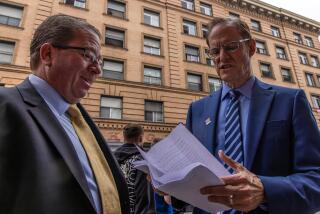Editorial: Paint companies poisoned people with lead additives. Now they want a billion-dollar bailout
This isn’t the first time Californians have faced a misleading, self-serving ballot initiative bankrolled by special interests. But the chutzpah behind the Healthy Homes and Schools Act sets a new standard.
The initiative was developed by three paint companies — Sherwin-Williams, Conagra and NL Industries — after they lost a nearly two-decade-long legal fight over toxic lead in their products. Late last year, a state appeals court mostly upheld a 2014 trial court ruling that found the companies marketed lead paint as safe even though they knew it was poisonous, especially to children. Lead-based paint was banned for residential use in 1978.
The ruling makes the companies liable for the cost of removing lead paint from homes built before 1951 (the year they stopped marketing lead-infused products) in Los Angeles County and nine other jurisdictions that filed the lawsuit. The case is now back in the trial court to determine how much the companies will have to pay toward removing all that paint; the total is likely to reach hundreds of millions of dollars.
The companies’ solution? Persuade voters to negate the judgment. That’s the point behind the Healthy Homes and Schools Act, which has attracted enough signatures to qualify for the November ballot.
On the surface, the initiative sounds virtuous. The proponents say they want to provide funding to clean up environmental hazards in homes and schools that could leave the poorest, most vulnerable Californians at risk. Who wouldn’t want to protect poor children? The initiative would direct the state to borrow $2 billion to pay for the removal of lead, mold, asbestos and other hazardous materials. The actual cost to taxpayers, after paying interest on the bonds, would be nearly $4 billion.
The initiative would declare that lead paint is not a public nuisance, even though the court found that it was.
But the real purpose is buried in legalese. The initiative would declare that lead paint is not a public nuisance, even though the court found that it was. That declaration would effectively reverse the court decision that put the paint companies on the hook, eliminating their obligation to pay for lead paint removal. It would also prevent other communities in California from suing paint companies in the future.
As a consequence, the tremendous cost of making older homes safe would be shifted from the paint companies that knowingly sold a highly dangerous product to the taxpayers.
While lead paint has been banned for decades, it remains present and a risk in many older homes, particularly in poorly maintained properties. As the paint deteriorates, it flakes, chips and turns to dust. Swallowing even small amounts of lead can cause permanent brain damage in young children, leading to lifelong learning disabilities and behavioral problems.
There are plenty of precedents for the sort of self-serving ballot measure the paint companies are attempting to pass. In 2008, billionaire Texas oilman T. Boone Pickens’ company tried to persuade voters to approve $5 billion in taxpayer-funded bonds to help Californians buy natural gas vehicles, which would have provided lots of customers for his natural gas filling stations. Voters rejected it. Mercury Insurance twice sponsored initiatives to roll back a state law that required car insurance premiums to be based on a driver’s safety record and not extraneous factors. Both measures failed.
“Big Paint” is now trying to use the initiative process to overturn a court decision and evade the penalties. But the companies’ resolve could be cracking. One of the three defendants, NL Industries, agreed this month to pay $60 million to settle the case and to drop its support for the initiative.
Meanwhile, state lawmakers have proposed a package of bills designed to counteract the initiative and make it easier to sue companies for the cost of removing lead paint. One of the proposals also would make paint manufacturers pay a fee to cover lead paint removal; the fee would go into effect only if the initiative passes.
If these bills are approved, it’s a sure bet that the paint companies and the state will end up in court. That means more money would be spent fighting over responsibility and less on protecting children from lead poisoning.
There’s still time to keep an ill-intentioned initiative from appearing on the November ballot. The paint companies have until June 28 to pull the Healthy Homes and Safe School Act. They should yank their self-serving initiative off the ballot and really start making homes healthy.
Follow the Opinion section on Twitter @latimesopinion and Facebook
More to Read
A cure for the common opinion
Get thought-provoking perspectives with our weekly newsletter.
You may occasionally receive promotional content from the Los Angeles Times.






